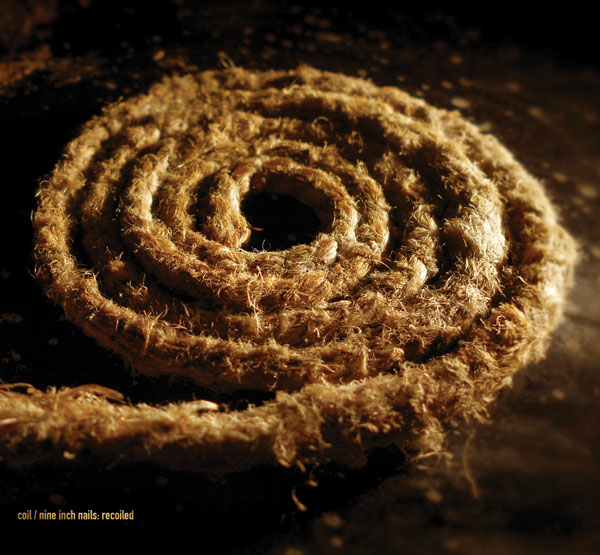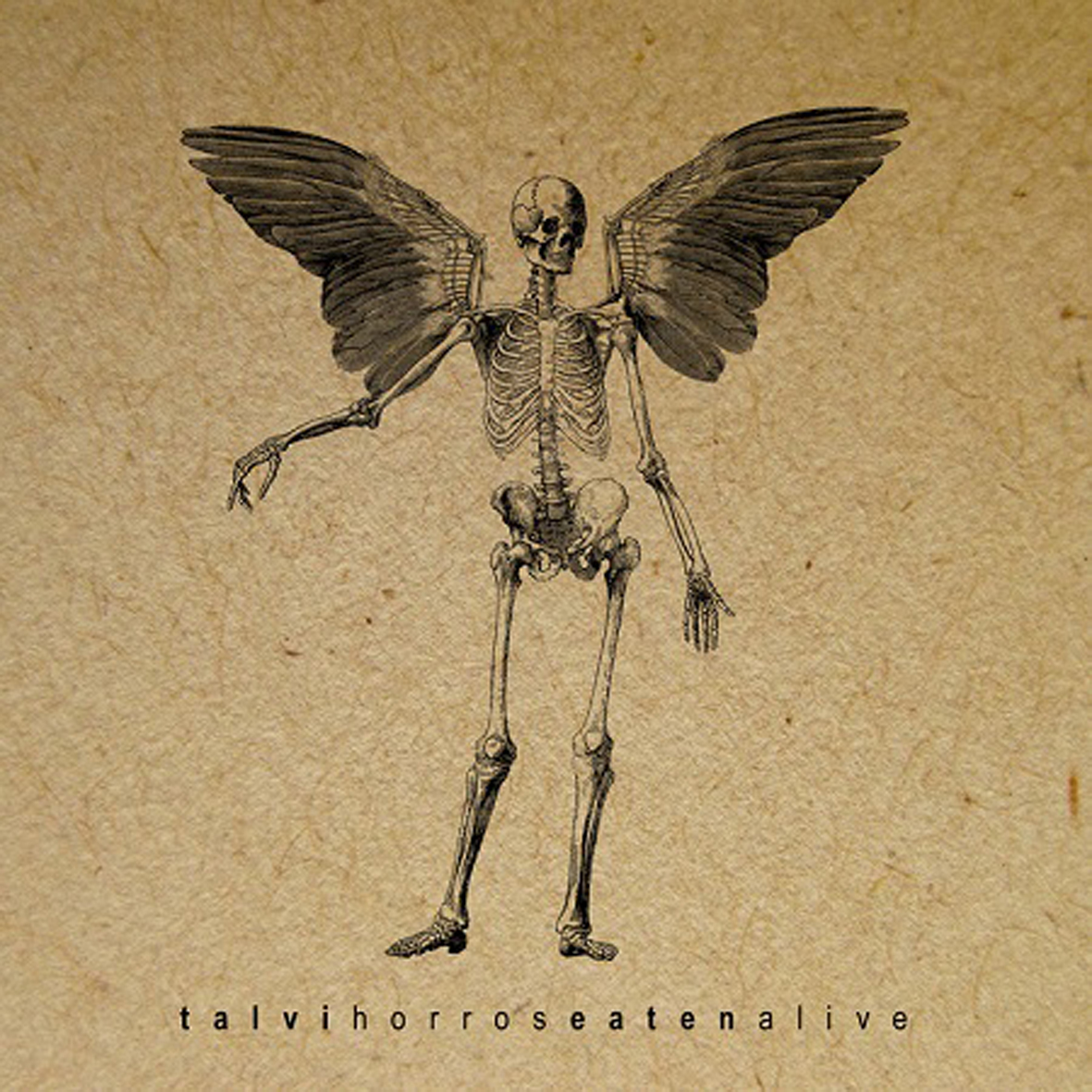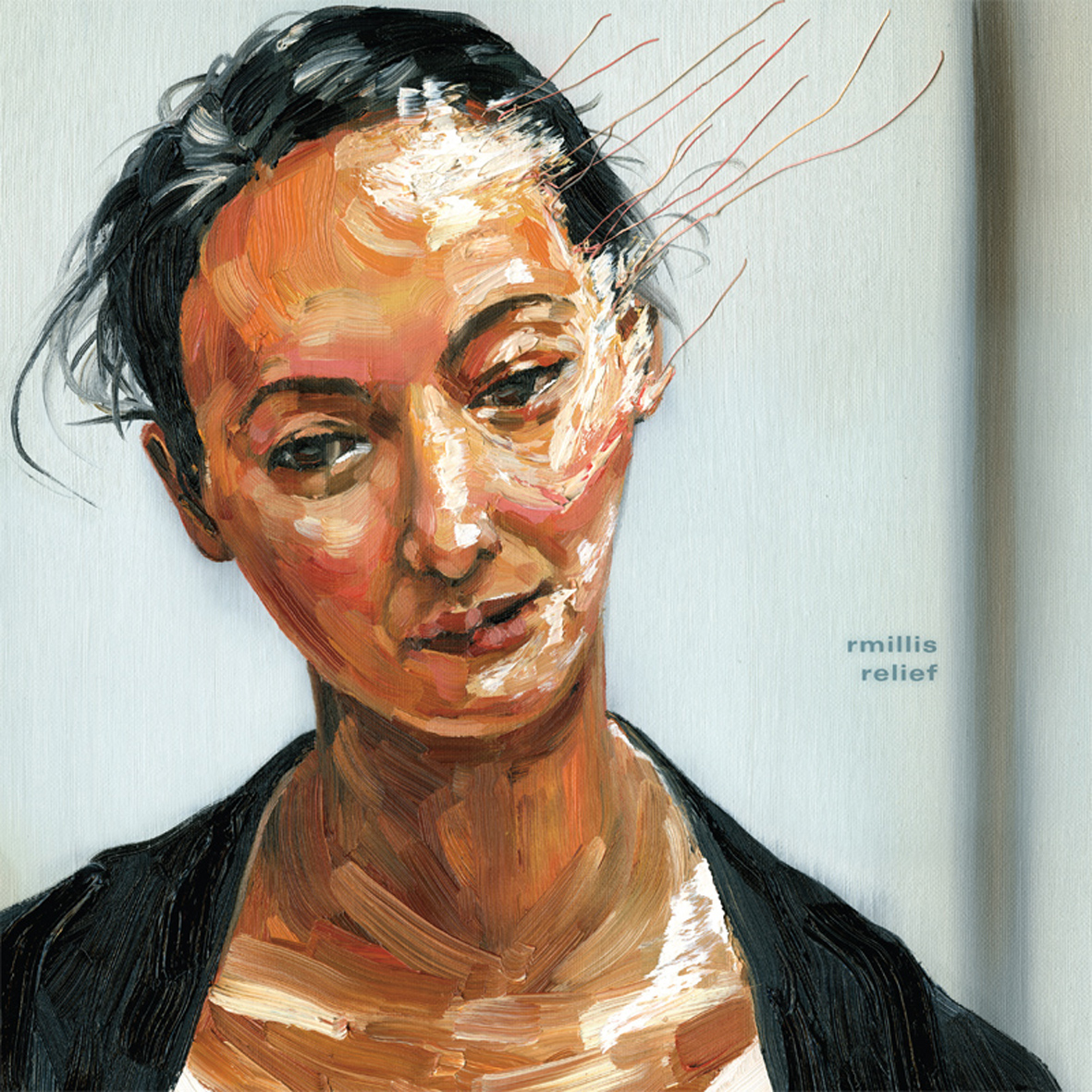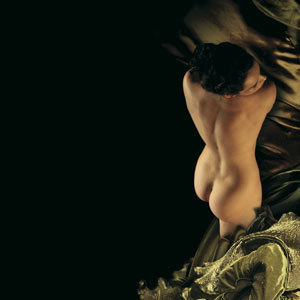- Administrator
- Albums and Singles

Artist: Coil / Nine Inch Nails
Title: Recoiled
Catalogue No: CSR193CD / Barcode: 5060174956799
Catalogue No: CSR193LP / Barcode: 5060174956805
Format: CD in digipak / Ltd LP on coloured vinyl
Genre: Industrial / Experimental
Shipping: 23rd January
“Recoiled” is a rambunctious alchemy, of magikal Coil sensibilities and hi-tech home circa 90’s mixing technique, all fused in the cave-like early studios of Danny Hyde / Peter Christopherson. These were the unrestrained PRE- BIG studio- mix downs, of four songs which long time Coil admirer / collaborator Trent Reznor requested Coil to remix. Reznor sent over the original multi-tracks and DATs to Hyde / Christopherson, who independently mixed versions and then met to synch both creations, molding them into these master versions. ”Recoiled” includes a fuller, more opulent version of the track ‘Closer’, which eventually made it onto the opening credits to the movie “SE7EN“. These 5 lengthy compositions are pre-Ableton / laptop generation type priest song creations, with the use of baby alarms and numerous wires to create bespoke effects. These legendary tracks were always rumoured to exist and, only the due diligence of a dedicated NIN forum who hunted them down, are released/unleashed for your listening pleasure. 4 of the tracks were released on the download-only “Uncoiled”. A bonus, previously unheard track from the same sessions closes the album. Jhonn Balance is also manifest on this gilded constellation. Beautifully remastered for CD / vinyl. CD in digipak.
Read More
- Administrator
- Albums and Singles

Artist: Psychic TV
Title: Live At Thee Marquee
Catalogue No: CSR189CD
Barcode: 5060174956768
Format: CD in jewelcase
Genre: Industrial / Esoteric
Shipping: Now
PSYCHIC TV’s complete, unheard show, recorded at the prestigious Marquee Club, London, 20th May 1986. For this event Psychic TV were: Genesis P-Orridge, Alex Fergusson, Mouse, Matthew Best. Ltd x 1000 copies, featuring an 8-page booklet of unseen photos.
Tracks: 1. Intro / 2. Ov Power / 3. She Touched Me / 4. Just Like Arcadia / 5. Supermale / 6. I Like You / 7. Riot In Thee Eye / 8. Interstellar Overdrive / 9. Unclean / 10. Godstar / 11. We Kiss / 12. Roman P. / 13. IT
Read More
- Administrator
- Albums and Singles

Artist: Psychic TV
Title: Thee Fabulous Feast Ov Flowering Light
Catalogue No: CSR188CD
Barcode: 5060174956751
Format: CD in jewelcase
Genre: Industrial / Esoteric
Shipping: Now
PSYCHIC TV in a unique line-up – a unique show, recorded 19th May 1985 at Hammersmith Palais, London. For this event Psychic TV were: Genesis P-Orridge, Alex Fergusson, Max Prior, Mouse, Hilmar Örn Hilmarsson, Dave Ball (Soft Cell), Rose McDowall (Strawberry Switchblade, Sorrow, Coil, Current 93). This is a completely unheard show, with unseen photos! Ltd x 1000 copies.
Tracks: 1. Intro, 2. I Like You, 3. Just Like Arcadia, 4. Godstar, 5. Roman P., 6. Unclean, 7. Baby's Gone Away, 8. Southern Comfort, 9. We Kiss, 10. Thee Starlit Mire, 11. Ov Power.
Read More
- Administrator
- Albums and Singles

Artist: Psychic TV
Title: Hacienda
Catalogue No: CSR187CD
Barcode: 5060174956744
Format: CD in jewelcase
Genre: Industrial / Esoteric
Shipping: Now
PSYCHIC TV, 5th November 1984, Manchester. This was PSYCHIC TV’s first show at NEW ORDER / FACTORY’s legendary HACIENDA club! For this event Psychic TV were: Genesis P-Orridge, John Gosling (Zos Kia, Coil), Paul Reeson, and Alex Fergusson. This is the complete show with unseen photos! Ltd x 1000 copies.
Tracks: 1. Intro / 2. Enochian Calls / 3. I Like You / 4. Unclean Monks / 5. Unclean / 6. Roman P. / 7. Southern Comfort / 8. Godstar / 9. Thee Starlit Mire / 10. Thee Shining
Read More
- Administrator
- Albums and Singles

Artist: Tunnels Of Ah
Title: Lost Corridors
Catalogue No: CSR184CD
Barcode: 5060174955433
Format: CD in jewelcase
Genre: Industrial / Esoteric
Shipping: Now
Tunnels Of Ah is the new project of former Head of David vocalist Stephen Ah Burroughs. “Lost Corridors” is the first Tunnels Of Ah release and features Burroughs’ “industrial esoterica”, evoking the spirit of the pioneering underground experimental scene in the new dark age. This is psychick war.
A mandatory release for those who worship at the altars of Coil, Psychic TV, Arktau Eos, Z’EV…
Tracks: 1. From A Cracked Hive (Black Insect Laughter) / 2. The Nightjar Sang A Kalpa Blaze / 3. A Net Of Woven Starlight
4. Nightfall At The Mount Of Husks / 5. Harvest Flame The Christ Force / 6. Shattering The Black Crone / 7. Crush The Heads Of Scorpions
Read More
- Administrator
- Albums and Singles

Artist: Z'EV
Title: A Handful Of Elements
Catalogue No: CSR182CD
Barcode: 5060174955457
Format: CD in jewelcase
Genre: Industrial / Ritual / Ambient
Shipping: Now
With “A Handful Of Elements” Z’EV returns to the “dense, carefully laid and deep drone works” [adnoiseam.net] of “Sum Things” (CSR101CD). However, for this release he has drawn deep from his 40 year old sonic archive (from live performances both instrumental and vocal to a range of soundscapes from around the world), producing soundtracks to accompany you to the other side of ambient, through the door between your eyes.
Tracks:1. Terra / 2. Aqua / 3. Aer / 4. Ignis / 5. Spiritus
Read More
- Administrator
- Albums and Singles
 Ben Chatwin is not one to shy away from ambitious concepts, having previously devoted albums to both the subconscious and the creation of the world.  Now, in collaboration with Fluid Radio's Dan Crossley, he tackles the more intimate subject of their shared alienation and misery in London.  Curiously, however, the music and packaging of Eaten Alive are much more elaborate than anything Chatwin has ever done before.  I had some difficulty reconciling myself with that, as something is definitely lost in Chatwin's transition from experimental guitarist to full-blown composer/urban historian/multimedia artist, but he certainly made a valiant and impassioned effort to do something truly unique and special this time around.
Ben Chatwin is not one to shy away from ambitious concepts, having previously devoted albums to both the subconscious and the creation of the world.  Now, in collaboration with Fluid Radio's Dan Crossley, he tackles the more intimate subject of their shared alienation and misery in London.  Curiously, however, the music and packaging of Eaten Alive are much more elaborate than anything Chatwin has ever done before.  I had some difficulty reconciling myself with that, as something is definitely lost in Chatwin's transition from experimental guitarist to full-blown composer/urban historian/multimedia artist, but he certainly made a valiant and impassioned effort to do something truly unique and special this time around.
Chatwin's music has always tended towards the cinematic, addressing compelling themes evocatively and with a thoughtful narrative and dynamic arc.  Eaten Alive certainly continues that tradition, but does so in a different way, resembling a soundtrack to a non-existent film rather a complete, fully-formed world of its own.  In a way, however, "the non-existent film" that Ben is soundtracking is actually the very real life of Crossley–specifically Dan's tales of addiction, crime, and homelessness in '80s London.  Crossley's contribution extended beyond just providing inspiration though, as the now sold-out limited edition further (and more concretely) illuminates his past with a booklet of his haunting, grainy photography from the period.  As a complete piece of art, that edition succeeds beautifully in many ways, but that success becomes quite a bit blurrier when the music is decontextualized and presented alone.
Another problem is that while Chatwin had no trouble brilliantly tackling the more abstract ideas of subconsciousness and dreaming with 2011's Descent into Delta, the seemingly more modest and tangible challenge of evoking a period from someone's life is one that does not suit his aesthetic nearly as well.  For an album that openly sets out to reflect the worst of human nature, Eaten Alive often feels like a very polished, muted, detached, and monochromatically melancholy affair.  Occasionally, Ben hits upon something inspired and apropos, like the roiling, buzzing, and snarling intro to "Little Pieces of Discarded Life," which sounds wonderfully like a broken televison in a ruined flat reluctantly coming into focus.  Many other times, however, Chatwin's music sounds positively baroque (such as in the crescendo of "The Secrets of the Sky").  There is nothing objectively wrong with that (it sounds like Talvihorros collaborating with John Carpenter on the credit music for a zombie film), but it feels like a bizarre choice given Eaten Alive's aim (but totally appropriate for its title, obviously).
Yet another problem is probably me and my preconceived idea of what I want a new Talvihorros album to sound like, as there are objectively a lot of very cool passages strewn thorough these 8 pieces, such as the heavy, buzzing outro of "Becoming Mechanical."  Also, there are a number of strong melodies and the whole thing forms a meticulously executed and coherent arc.  If I could just experience this album in a completely different context and forget that it was a Talvihorros album, I could probably enjoy it a lot more than I do, but I cannot.  I desperately want this album to be intimate and occasionally raw and violent (like life), but the complexly layered arrangments, deliberate pace, and homogenizing synth parts make me feel like I am listening to Mogwai covering a classic In The Nursery album or something.  I would have no (serious) problem with such a union occurring, but hearing Chatwin sound like that makes me wince a little.
Of course, all of my griping is rooted in the fact that I historically love Talvihorros, which has the unfortunate effect of saddling me with all kinds of critical baggage and expectation.  While I definitely prefer Ben's last two releases to this one, I am (grumblingly) still quite pleased that Eaten Alive exists: Chatwin and Crossley certainly cannot be faulted for lack of vision or effort and they break some interesting new ground in the realm of...what?  Experimental documentary (so experimental that there is not even a film)?  Abstract sonic biography?  I have no idea.  In any case, this was an excellent idea for a project that probably thoroughly delighted the 200 people who got the complete experience.  As pure music alone, it does not necessarily work for me, but I hope Ben is not dissuaded from taking similarly bold chances in the future.
 
 
Read More
- Administrator
- Albums and Singles

Robert Millis is not exactly a household name, but anyone with a healthy curiosity for the musical fringes has probably unknowingly encountered at least one thing that he has been involved in over his lengthy career.  Recently, he has been most prolific as a filmmaker for Sublime Frequencies, but he has also curated or worked on some of the most interesting compilations to emerge over the last several years (Dust-to Digital's Victrola Favorites, for example).  He is also one of the founding members of Climax Golden Twins as well as an occasional solo artist, as he is here.  Appropriately, Relief seamlessly blends together many of Millis' esoteric pursuits, but it does so in a more understated, raga-drone way than I expected.
Curiously, this album is described by the label as "more Nurse With Wound than The Caretaker," invoking two artists that have little overt resemblance to what it is that Millis does.  There are certainly fleeting elements of both (brief snatches of surrealist whimsy and brooding orchestral passages, respectively), but Relief does not particularly warrant comparisons to any auteurs, resembling a fairly straightforward drone album assembled from very unstraightforward materials.  It is certainly a very good drone album, but its distinctive traits are generally quite subtle, abstract, or ephemeral in nature.
The most uniquely Millis-ian touch to be found is that many of the droning, repeating motifs sound like they could be blurred, stretched, and pitch-shifted samples from some long-lost Molam or Luk Thung obscurities or one of Robert's recently anthologized 78s from Korea or Burma.  Almost all of these five pieces betray those origins or inspirations in one way or another, but they all offer their own twists to the formula as well.  The most successful of the lot is probably the opening "Secret Sentence," which buffers its hazy burbling loop with a kitschy old dialogue snippet and an unexpected plunge into dark orchestral tumult.  The closing title piece is similarly successful, yet radically different in structure, spending most of its 16 minutes engaging in gently quavering, one-chord drone before slowly giving way to what sounds like an especially insistent dripping.
The other aspect to Relief that stands-out is a particularly weird, muted strain of unpredictability.  The aforementioned "Relief," for example, continues beyond its logical conclusion point into a throbbing, hallucinatory coda mingled with pastoral piano noodling.  Also, the aberrant "Second Lord of the Auspicious Conjunction" is wrong-footing in almost every respect, sounding like snatches of a classical album being heard through some kind of disquieting and dissonant supernatural fog before being violently interrupted by vinyl crackle and returning as a new piece.  The overall feeling is like having a nightmare about an indecisive ghost who cannot make it through an entire song without restlessly flipping the record.  Which, of course, is fairly novel and enjoyable (for me, anyway).
Ultimately, Relief feels like a somewhat slight album, but endearingly and willfully so.  Part of me definitely wishes Millis had not devoted so much of its running time to simple droning loops and repetition (and amateurish one-finger piano interludes), yet Millis' patience, confidence, and odd sensibility give the album a woozy, sublime, and unhurried charm.  In that deeper and somewhat nebulous sense, this effort is actually quite unique: Millis is the rare artist who egolessly lets sounds flow (rather than conspicuously exerting his will) and hints at depth and exoticism (rather than making things explicit).  While Relief sounds contemporary, it feels like it comes from a very different aesthetic place than the here and now.  Which, I suppose, makes it something of a minor triumph.
 
 
Read More
- Administrator
- Albums and Singles

Somewhere in the rainy, misty forests of the Pacific Northwest of America, three ladies have the unlikely task of sewing together the packaging for a new album by Zoviet France.
The Tables Are Turning, released by Soleilmoon Recordings on November 18, consists of recordings from the soundtrack to the contemporary dance production, "Designer Body." The dance, premiered by British dance company, Ballet Lorent, in 2008, explores the transformational relationship between humans and the clothing they wear.
Seven dancers, performing on continuously rotating plinths, slowly remove layers of their costumes, revealing the sensuous nude bodies beneath. The music accompanying the dancers is by turns dense and moody, then lyrical and soaring, underlining the mounting vulnerability of the dancers as they undress.
Liv Lorent, Ballet Lorent's artistic director and choreographer, spoke with Kelly Apter, writer for The List, saying "At the beginning, the body is the most designed it can be. They're wearing hats, coats, heavy costumes and make-up – all the man-made and artificial things we do to disguise ourselves everyday. Then, over 18 minutes, we take it all away. And because there are several layers, there's a real sense of metamorphosis."
The members of Zoviet France, who prefer to remain anonymous, write “We've known Liv Lorent for a long time. When she started to conceive 'Designer Body,' which she wanted to be a hybrid of contemporary dance and performance art, she decided that an unconventional performance needed an unconventional soundtrack. The composition of the soundtrack and the choreography evolved alongside each other so it became a dialogue between Liv and ourselves. The main inspiration that we took from the production's concept was rotation; throughout the one hour performance, the dancers are located on turntables that turn continuously, at varying speeds and changing direction. We mirrored this in much of the soundtrack, with circular and rotating sounds."
More information cam be found here.
Read More
- Administrator
- Albums and Singles

In 2006, Hisham Mayet returned to West Africa to continue his search for an unknown musician he had heard six months earlier on the radio in a Morocco hotel room. Knowing only that it was Sahrawi music — music of the south — he headed down through the vast and remote desert landscape of the Western Sahara and Mauritania in hopes of finding someone who could identify these revelatory recordings.
That artist was Group Doueh. But he also found much, much more as he wandered from Laâyoune, Western Sahara, to Mauritania's capital city of Nouakchott: From intimate, sinuous home recordings by Group Marwani, to a sublimely devastating track by the enigmatic Abdul Rahman Al-Gheid, to the inimitable tidinit artistry of Sadoum Ouled Aida, the performers on this album exemplify the haunting and intoxicating qualities of Sahrawi music.
Featuring Mayet's first recordings of the electrifying Group Doueh, as well as dizzying field recordings from Nouakchott's Marché Capitale — where relentless traffic noise swirls together with fragments of melody from countless cassette vendors’ PA speakers— Hassānīya Music from the Western Sahara and Mauritania is the evocative soundtrack to a chimerical journey that is also documented visually in Sublime Frequencies’ breathtaking film Palace of the Winds. It not only traces Mayet's own passage through these barren and beautiful lands, but also charts the evolution of Sahrawi music from sung poetry accompanied by traditional acoustic instruments to electrifying modern grooves drenched in reverb and phase effects.
Limited edition pressing with Stoughton tip-on full color gatefold jacket.
More information is available here.
Read More
- Administrator
- Albums and Singles

In 2005, Sublime Frequencies released Choubi Choubi: Folk and Pop Sounds from Iraq, and in the ensuing years it has become one of the most beloved and venerable titles in their catalog. Now, almost nine years later, this highly anticipated second volume is finally here. Compiler and producer Mark Gergis has once again put forth a revelatory and poignant collection of Iraq's national folk music.
The musical style most prominently focused on in this volume is the infamous Iraqi choubi, (pronounced choe-bee), with its distinct driving rhythm that can feature fiddles, double-reed instruments, bass, keyboards and oud over its signature beat. Choubi is Iraq's version of the regionally popular dabke, another celebratory Levantine folkloric style of rhythm and line dance. What really defines the Iraqi choubi sound are the crisp, rapid-fire machine-gun style percussive rhythms set atop the main beat. To the uninitiated, they sound almost electronic. Sometimes they are, but more often this is the work of the khishba – a unique hand-drum of nomadic origin (aka the zanbour – Arabic for wasp), which appears across the board in many styles of Iraqi music today, with extensions of it also heard in Syrian and Kuwaiti music. Among other styles featured in this volume are Iraq's legendary brand of mawal – an ornamental vocal improvisation that sets the tone of a song, regardless of the style, and the outstanding Iraqi hecha, with its lumbering and determined rhythm pulsing beneath sad, antagonized vocals.
The tracks on this collection were produced during the Saddam era – between the 1980s and early-2000s. An important goal within the Iraqi Baathist agenda was to promote its brand of secularism, which saw the establishment of cultural centres, and a fostering of the arts. Music was more encouraged, albeit more institutionalized than ever – particularly folkloric and heritage music such as choubi. In an Iraqi army comprised of seven divisions, Saddam referred to singers as the eighth. Still, unless a rare level of stardom has been achieved, being a singer or musician isn’t usually encouraged or viewed as a respectable lifestyle in much of the Arab world. It’s often those deemed social outsiders that tend to find their niche in music – particularly the "party music" heard on this collection. Among them are the Rom Gypsy Iraqis (known as Kawliya in Arabic). A number of female singers wear masks and adopt pseudonyms to protect their identities, as some are runaways or prostitutes making ends meet in the seedy nightclub scene. Occasionally, they end up with successful recording careers.
Sajida Obeid, who has appeared on both volumes of Choubi Choubi! is an example of a talented Kawliya singer from the nightclub scene of the 1980s who rose to choubi infamy in Baghdad. Choubi inevitably invokes tawdry connotations within Iraqi society (cheap nightclubs for the lower classes, outcast gypsies and singing prostitutes), but in fact, many calibers of Iraqi singers and ensembles have recorded and performed the music.
Unofficially, choubi can be called the national dance of Iraq. Though some may deny this claim (mostly due to its reputation and stigma), at most Iraqi weddings you'll find people from all walks flaunting their best choubi moves. Iraqi music has always had a way of transcending religious groups and ethnicity, collectively shared between Arabs, Kurds, Assyrians and myriad other Iraqi minorities. In 2013 sadly, this diversity and unity within Iraq is increasingly fragmented, but traditions continue throughout the internationally displaced diaspora.
(Limited edition 2-LP set in heavy gatefold jacket with beautiful artwork and liner notes by Mark Gergis)
Read More